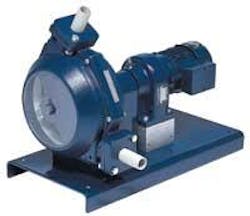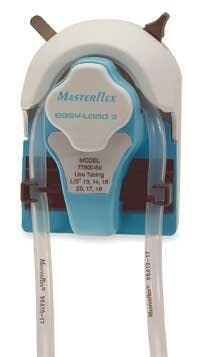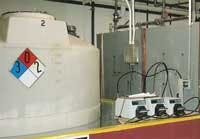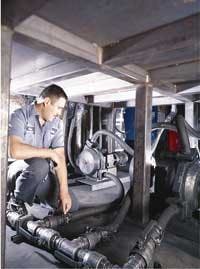Peristaltic Pumps Evolve into a Reliable, Multi-Functional Option for Water Applications
Thanks to its inherent design and today’s high-tech materials, the peristaltic pump is being adopted into many key water and wastewater treatment applications. Its avoidance of chemical attack, abrasive wear and clogging, salt settlement and vapor locking can make it an ideal workhorse for dosing, chemical delivery and product transfer.
Not too long ago the peristaltic pump was considered a great idea that just didn’t work in the harsh reality of most water and wastewater treatment applications. The idea in which a fluid being pumped never actually touches the pump, only the inside of the tubing it squeezes, is a great one; the basic design is several millennia old. However, the long-standing problem with peristaltic pumps in most water and wastewater treatment applications had never been with the pump’s design, but with the tubing.
Conventional tubing materials just couldn’t hold up to the harsh demands of the service. In addition, lack of reliable tubing had long limited peristaltic pump capacities. But that all changed with the development of today’s high-tech tubing materials that can last up to 10,000 hours or more in operation. These advances in hose and tubing technology have driven this pump design to now allow for long-term operation and pumping capacities ranging from 0.001 mL per minute up to 175 gpm, and higher.
How They Work
Peristaltic pumps (often referred to as “tubing pumps,” and their higher-capacity kin, “hose pumps”) operate on a positive displacement principle that uses rotating rollers to occlude, or squeeze, fluid through elastomer tubing. This flexible tubing has the suction and discharge nozzles attached at each end and the pump employs a drive-coupled rotor with mounted shoes (or rollers) that squeeze the tube against an occlusion bed along a fixed path. As the rotor completes each revolution, the fluid moves forward at a constant rate until it reaches the discharge nozzle, while the tubing or hose behind the compression point returns to its original round shape, creating suction at the pump inlet port and the hose bore refills with the medium.
The fluid being pumped never touches the pump, which means the pump will last longer, and the same pump can be used for various fluids by simply changing the hose or tubing. With peristaltic pumps, there are no wetted parts other than the tubing and hose materials -- plus there are no valves or seals. The units are self-priming (to 29 feet down), can operate dry without damage, produce no siphoning effect when stopped, have an accuracy rate better than 1 percent and are easy to maintain. Due to these and other advantages, peristaltic pumps are now viewed as viable alternatives to diaphragm metering, lobe, gear and processing cavity pumps in meeting the stringent challenges in water and wastewater treatment applications.
Outgassing Media
Outgassing is a common problem with feeding commercial sodium hypochlorite (NaOCl), hydrogen peroxide and other oxidative disinfectants commonly used at water and wastewater treatment plants. Outgassing occurs when a pocket of vapor forms in the fluid line and obstructs the normal flow. This can cause system leaks and air bind chemical metering pumps (typically, piston or diaphragm pumps), often resulting in unscheduled downtime and poor process performance.
With peristaltic pumps, however, the squeezing action of the flexible tubing against the pump’s occlusion bed generates a powerful vacuum that moves both gases and liquids without clogging or producing vapor lock.
In addition to feeding sodium hypochlorite and other oxidants, peristaltic pumps are also a viable alternative to traditional pumping and metering methods for virtually all other chemical applications at water and wastewater treatment facilities. Besides accuracy and repeatability, the pump design’s inherent chemical resistance is also important. Extremely aggressive materials such as ferric chloride can attack the wetted parts of metering pumps, eventually making measurements unreliable. But because the peristaltic pump design keeps the fluid inside the tubing at all times, the fluid cannot contaminate and damage the pump or meter.
Flocculants/Polymers
Low shear, combined with high volumetric accuracy, make peristaltic pumps also very effective for handling flocculants, polymers and other shear-sensitive materials used in water and wastewater treatment. With neat polymer applications, for example, high shear can damage the extending polymer molecule chains or cause agglomerations called “fisheyes” that provide little value for flocculation. Due to the gentle pumping action provided by the peristaltic operation principle, the fluid is not subjected to any mechanical grinding or shearing action from gears, valves or other elements, thereby leaving solid components of the fluid intact.
Semi-Solids & Abrasives
Peristaltic pumps are also well suited for handling very thick fluids with high solid content, such as feeding primary or thickened sludge and transferring lime slurries. Primary sludge typically has unpredictable flow characteristics due to its heavy abrasive content and widely varying viscosity. When abrasive slurries and semi-solids products are involved, tubing/hose pumps offer several advantages. Peristaltic pumps are naturally abrasion resistant because of the tubing/hose action. And because the pumps adapt well to viscous friction loss in the piping, they are especially well suited for the higher pressures required to move the fluid. Peristaltic pumps also work well in primary sewerage and scum/grit pumping where lobe-style pumps can experience seal and abrasion problems.
Ensuring Sample Integrity
Automatic wastewater samplers are important tools in monitoring discharges to receiving waters. With a vacuum pump sampler, samples pass and then are retained in a metering chamber. Because the chamber cannot be adequately rinsed and cleaned between samples, this can potentially lead to cross contamination of samples. With peristaltic pump samplers, however, samples are pumped directly into a separate container and the tubing can then be purged and rinsed before each sample. In addition, studies have shown that the intake velocities of peristaltic pump samplers are close to the intake velocity of the actual flow stream, allowing sample values to more closely reflect the values generated when collecting samples manually.
Conclusion
It was not until the 1990s that hose and tubing technology developed to provide peristaltic pump performance rivaling that of other pump technologies. Today, due to its many proven performance, maintenance, and fluid materials handling advantages, peristaltic pumping technology is becoming an accepted fluid handling design for dosing, chemical delivery and product transfer in water and wastewater treatment.
About the Author:
Gregg E. Johnson is the Marketing Manger for Barnant Co. He has been working in the pump industry for more than 27 years, and specifically with peristaltic pump for more the 16 years.




